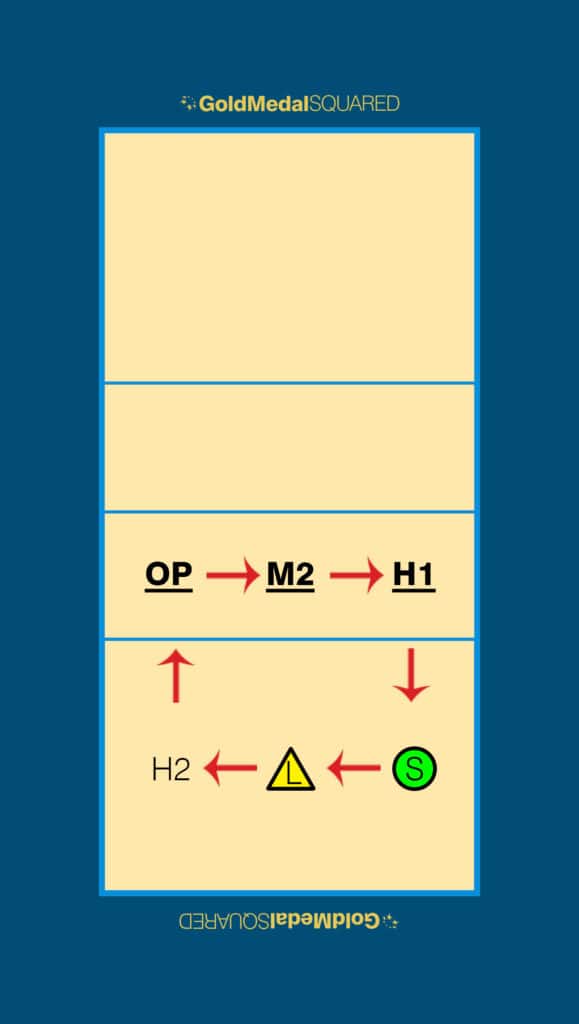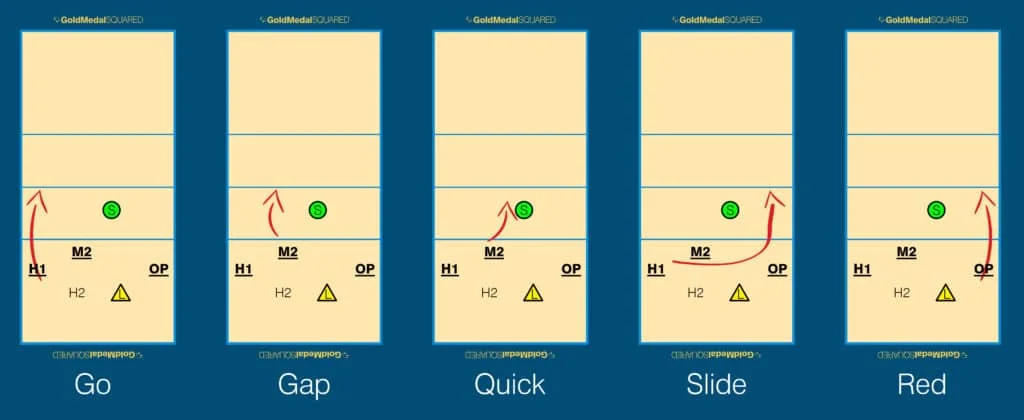VOLLEYBALL ROTATIONS – INTRODUCTION
Volleyball rotations, particularly for newer coaches, can be a bit confusing. It will take some time and experience to fully understand the nuances involved, but fear not! We have put together a detailed guide to ensure all of your questions are answered.
We have put together a 7-part blog series that includes the following information.
- A general overview of how rotations work and the overlap rules involved.
- A quick overview of the positions in volleyball, and how they are utilized in each rotation.
- The typical offensive set calls in each rotation.
- An in-depth look at volleyball rotations 1-6 (see links below to access each rotation).
Player Positions
One of the first steps in learning volleyball rotations and overlap rules is understanding player positioning on the court.
In a traditional 5-1 offense, there is 1 setter, 2 outside hitters, 2 middle blockers, an opposite, and a libero. Here are the descriptions of each player position:
- Setter (S) – The setter’s “base” or starting position in rotation 1 will be left back. Often times serve-receive formations will be set up in a way that allows the setter to get in to position using an efficient route.
- Outside Hitter 1 (H1) – The H1 is the outside hitter closest to the setter. Typically, this should be the best outside hitter on the team because she will generally have more hitting opportunities than any other player.
- Middle Blocker 2 (M2) – The M2 is the middle blocker two spots away from the setter.
- Opposite (OPP) – The Opposite is a right side attacker lined up directly opposite of the setter.
- Outside Hitter 2 (H2) – The H2 is the outside hitter two spots away from the setter.
- Middle Blocker 1 (M1) – The M1 is the middle blocker one spot away from the setter. Usually the M1 will be the better offensive middle attacker because she will have more hitting opportunities than the M2. The M1 should also be a better slide hitter because she will have more opportunities to hit slides.
- Libero (L) – The Libero plays replaces the back row Middle Blocker.
Rotating in Volleyball
When a team is receiving serve, we call this the offensive or side-out phase of the game. When a team wins in serve-receive, we call this a “side-out.” This means that they go from receiving to serving. When a side-out happens, each athlete will rotate one position clockwise.
In the diagram below, you will see that the H1 position will rotation one position clockwise, which will make him/her the next server.

Volleyball Overlap Rules
To ensure that the players are standing in legal spots when the ball is served, we need to understand volleyball overlap rules.
- These rules refer to the positioning of athletes on the court before the ball is served.
- Once the ball is served, athletes can move positions on the court. This is done to optimize player positioning on the court during the defensive and transition phase of a rally.
- No players can overlap with players directly in front or behind them, or directly to the left or right of them.
Overlap Examples

- In the first image, the Setter must be behind the H1 (Because the H1 is the player directly in front of her) and to the right of the Libero (because the Libero is the player directly to her left). The setter doesn’t have to worry about illegally overlapping with any other players.
- In the second image, the M2 must be in front of the Libero (because the Libero is the player directly behind her), to the left of the H1 (because the H1 is the player directly to her right), and to the right of the Opposite (because the opposite is the player directly to her left). The M2 doesn’t have to worry about illegally overlapping with any other players.
Offensive Attack Calls By Rotation
In this section, we will look at what offensive play calls are available by rotation. What plays you can run, and who you can set is dictated by the rotation you are in.
Go: A standard left side attack, typically with 2nd step tempo.
Gap: This set gets called a variety of names (gap, 31, shoot, 3). With this play, the the middle-blocker gets set in between the middle of the court and the left side of the court.
Quick: A quick attack hit by the middle blocker directly in front of the setter. This is also commonly called a “1.”
Slide: An attack on the right side of the court, starting from the middle of the court, using a one-footed takeoff approach.
Red: A standard right side attack, typically with 2nd step tempo.


